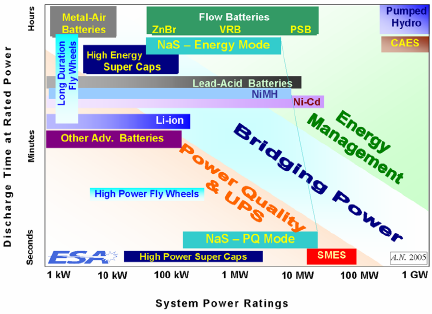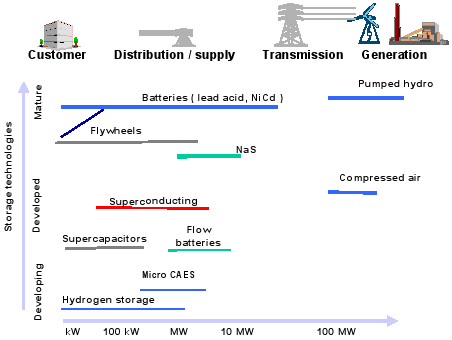Electricity Storage in The Netherlands
Posted by Marcel van der Steen in Energy storage Add commentsIs it available? Or can it be created? The Dutch program “Nieuwe Energie Onderzoek” of Senternovem gave the Utrecht Center for Energy Research the task to find out. Their final report researches whether electricity storage can be of support for a durable energy generation. Considered are three applicational areas:
- grid coupled storage systems
- autonomous storage systems
- electricity storage in transport media
Classification of available systems
Some systems are typically meant to deliver a lot of power in a short timeframe, such as flywheels and capacitors. Other systems can deliver a certain power for hours, such as pump accumulation plants and air pressure systems.
See below an image with many examples, with on its x-axis power and on the y-axis the discharge time.

(Source: Electricity Storage Association)
The different energy options are well explained in the final report, see for that pp 9, 10 en 11.
Besides, there are other ways to characterize storage systems, such as discharge losses when not charging or discharging to load (flywheels), the efficiency of a full charge and discharge cycle, the number of cycles in the total system lifetime, etc. A global overview of the characteristics of different energy storage systems is given in this table (see also the report, page 8).
| storage system | capacity | lifetime | self-discharge | efficiency cycle | typical discharge time | costs |
|---|---|---|---|---|---|---|
| unit | kWh | cycli | %/mnth | % | hour | €/kWh |
| Lead-acid battery | 1-40k | 200-1200 | 2-5 | 75-80 | 0,5-5 | 200-900 |
| NiMH & NiCd battery | 1-40k | 1k-3k | 0,5-2 | 60-70 | 0,2-1 | |
| Lithium battery | 15 | 3k-5k | 1 | 95 | 0,5 | 500-2500 |
| NaS battery | 1-50k | 1k-4k | None | 80-85 | 8 | 225-400 |
| Zink-Bromide battery | 50-500 | 1k | None | 65-75 | 0,5-3 | 1500 |
| Vanadium flow battery | 50-2k | 5k-12k | None | 80-87 | 1-8 | 100-500 |
| Regenesys flow battery | 120k | 1k5-3k | None | 70-85 | 1-8 | 600-3k |
| Metal-air battery | 1-10 | 100 | 7-10 | 40-50 | 1-8 | |
| CAES | -3M | 10s yrs | None | 50-80 | hours | 30-115 |
| Pump accumulation | -100M | 10s yrs | None | 70-85 | hours | 3,5 |
| Flywheels | 1-10 | 105-107 | NB: 30-40/hour | 90 | NB: sec-min | 1500 |
| Supercapacitors | 1-100 | 105-107 | 20-30 | 90 | NB: sec | 10k |
| SMES | 0,1-3 | 10s yrs | <1 | 95 | NB: sec | 300-2k |
With SMES is meant Superconducting Magnetic Energy Storage, and CAES means Compressed Air Energy Storage
Possibilities for Storage Systems
When reviewing all of the above mentioned options, see the following table showing the major possibilities lying within the area “Grid-coupled systems”.
| application area | storage type | Role (current) | Role (future) |
|---|---|---|---|
| Grid-coupled systems | Pump accumulation |
|
|
| CAES |
|
|
|
| Flow batteries |
|
||
| Batteries | Power security (UPS) | Power security (UPS) | |
| SMES | Voltage quality | ||
| Flywheels | Power security | Power security | |
| Autonomous systems | Batteries |
|
|
| Systems in transport vehicles | Batteries |
|
|
| Flywheels | Fuel saving (buses etc) | ||
| Hydrogen | Alternative energycarrier |
From a DTI study in 2004 I took the following figure, in which the development phase of different technologies is given as a function of their system power range and typical application area.

Source, DTI.
Big Scale Grid Coupled Systems
It appears from both overviews that for big scale grid coupled areas (> 100 MW) only pump accumulation systems are available as well as compressed air. In the future, the latter can obtain a bigger part of the market, especially when the adiabatic advanced storage (AA-CAES) is developed further with a higher efficiency.
Middle Scale Grid Coupled Systems
For middle size systems (0,1-10 MW) batteries (lead acid and NiCd) are still superior, but redox-flow batteries provide options as well. For short time power support in this range, flywheels are commercially available as well as SMES systems.
Small Grid Coupled Systems
For the small grid coupled storage systems (10-100 kW) the Ni-MH and Li-ion batteries are of increased importance, mainly for vehicle applications. Flywheels are used for trams and buses. Storage of hydrogen is still in a fundamental research phase.
Small Grid Coupled Systems
For the smallest storage systems (< 1kW) the Ni-MH and Li-ion systems are superior. In cases with high power demand of short duration, the use of super capacitors is appropriate. On this webpage we have an article on super capacitors, about one in development, and when this one becomes available, it will give a good potential for high power and long energy duration storage for use with wind turbine parks as well as potentially widely distributed (one in every home).
Support of the Durable Energy System
What is meant by durable energy system
In the above mentioned report, a durable energy system is defined as an energy system with the following characteristics:
- clean (i.o.w. the climate will not change or disturbed)
- safe (without big risks)
- efficient
- reliable
- affordable
- offers a long term perspective
- acceptable to Society
- supports local job opportunities and industrial development
- does not recognize “lock-in” effects
- preferably available all over the world
What is missing in this list, in my opinion, is the question of whether the __energy balance__ is positive. See also this article on energy balance. It may be implicit in point 6; where the energy system is required to offer a long term perspective. Also a remark on point 1, that it shall not disturb the climate. This is very subjective. One person might say a wind turbine disturbs the local climate, where the other will say the digging for new Uranium and disposal of used Uranium is disturbing the climate (see also the digging to Uranium.
My opinion about this list is that there are different priorities to be put on the different points measured, to be really meaningful. For instance, items 3 and 5 are not really of importance, and strictly speaking, perhaps not even points 4, 8,9 and 10. If we really focus on durable energy systems, then these shall fulfill the following items: 1, 2, 6, 7 and need definitely have a positive energy balance.
The Applicability of Grid Coupled Energy Systems
Different parties are interviewed and give their view on the applicability of different storage systems.
| Group / company | Directly applicable share | Indirectly applicable | |
| Grid coupled systems | KEMA | Storage is needed to introduce bog wind powers into the grid | |
| Tennet | Storage is needed to introduce bog wind powers into the grid | ||
| ECN | Storage to solve for imbalance gives cost reduction and indirect added value | ||
| Autonomous systems | Philips (and TU/e) |
|
|
| TU Delft | Storage brings solar energy nearer | ||
| Transport vehicles | CCM | Flywheels deliver a 10 % reduction at buses and trams | |
| Ecofys | Connect electricity supply with mobility: durable sources will soon feed PHEV cars |
Note: PHEV is a Plug-in Hybrid Electric Vehicle
The biggest contribution of electrical storage systems is to be expected in grid coupled systems, and this is also its biggest added value to the support of durable energy systems such as wind turbines and solar energy, that deliver a very variable power.




May 22nd, 2008 at 1:49 pm
Excellent article and very nice graphics. I saw this article on your Dutch website and am glad I can finally see it in English. I see a lot of relevance in this topic here in the States as we watch our energy prices soar. Until now most Americans have been content to depend on government to supply power but we are seeing more people looking for alternative energy sources now. Thanks for a very thought provoking piece.
June 8th, 2009 at 12:30 am
Thanks for information about Electricity Storage in The Netherlands,
December 21st, 2013 at 1:54 am
I am a research scholar. The information hosted in this web page are very useful. Thank you.